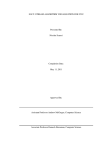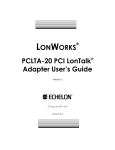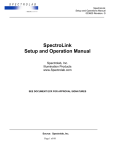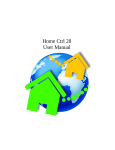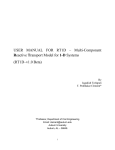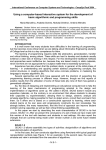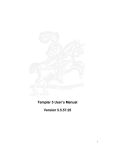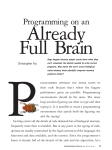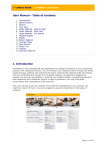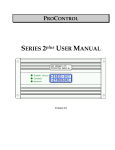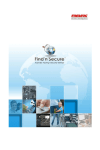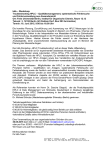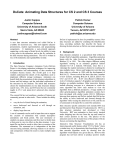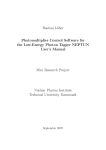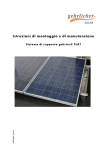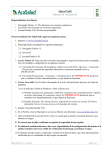Download Towards A Software Museum - Institut für Informatik
Transcript
Towards A Software Museum: Challenges and Opportunities Ernst Denert Klaus-Peter Löhr sd&m AG Thomas-Dehler-Str. 27 81737 München E-mail: [email protected] Institut für Informatik Freie Universität Berlin Takustr. 9 14195 Berlin E-mail: [email protected] & Introduction Although the history of automatic computation is quite young, the rapid development of electronic computers has awoken the interest of the historians, who fear important facts about early computing might get lost. The most visible result of the combined efforts of historians and computer veterans are computer museums which have been founded in several countries and have become quite popular. Computer museums belong to the category of science and engineering museums. Their exhibits tend to do more than just present some fancy machinery: they try to educate visitors, i.e., convey an understanding of how technical artifacts work and how they were perfected over generations of engineers. A prominent example of this kind of museum is the Deutsches Museum in Munich, one of the world’s most comprehensive science and engineering museums. Presenting computers in a museum has been done very successfully in the past, but has focused on only one part of the computing business (actually a small part)—hardware. The really important part—and one of the key technologies at the turn of the century and for a long time to come—is software. So why are software systems not presented in computer museums? The answer seems obvious: software is immaterial and invisible, so there is nothing to be presented. Or so we think. The authors set out to question this dogma. We are convinced that it is possible to make software an exciting exhibit in a museum - a software museum. Our opinion was confirmed when we visited the newly created Mathematical Cabinet in the Deutsches Museum. Here, Friedrich L. Bauer has managed to present the most elusive subject imaginable, mathematics, to the visitors, or at least to wet their mathematical appetite by allowing a playful encounter with strange objects1. It occurred to us that software, too, could be made visible, tangible and playful, and thus reach people. 1 Friedrich L. Bauer: Mathematisches Kabinett. Deutsches Museum, München 1999 2 Ernst Denert & Klaus-Peter Löhr The immaterial nature of software is not the only problem a software exhibition has to solve. The sheer mass of past and existing software, the disappearance of the supporting hardware platforms and the virtually unlimited range of applications make it hard to see how a software exhibition could ever cover its subject in an adequate way. In exploring the issues, we will first develop a few principles that we consider crucial to any successful attempt to create a software exhibition. Then, to make things more concrete, we will present three case studies of “exhibits”. Finally, several technical and organizational issues will be addressed. Basic Principles for a Software Exhibition Goals The raison d’être of any museum, whatever its theme, is to save characteristic items from oblivion, to preserve masterpieces, to present them as exhibits and thus to contribute to an understanding of the history of a specific field. The educational efforts range from almost non-existent (as in art galleries) to rather elaborate (as in ethnological museums). These three facets - exhibits, history, education - what do they mean for a software exhibition? While everybody knows what a painting is, few people know what a computer program is. So the educational aspect will be essential for any software exhibition. Only if people understand general software principles, concepts and techniques, will they be able to appreciate specific software exhibits and understand historical developments. This implies that, first and foremost, there has to be a software basics section which explains the basic notions of algorithm, program, software, and how all this relates to hardware. Then different kinds of software have to be covered, both systems software (operating systems, compilers, ...) and application software. For each kind, it is necessary to answer three questions: 1. What are the problems to be solved? 2. What are the typical approaches to solving these problems and how have these approaches evolved over time? 3. What are the prominent historical examples of that kind of software and how have they solved the problems? By way of an example, let us consider database systems: 1. (Problems) The ACID properties2 have to be guaranteed and efficient queries must be supported for large amounts of data. 2. (Approaches) Some typical techniques are indexing, locking, logging, etc., and we have seen more refined manifestations of these techniques in the evolution from indexed-sequential files to relational to object-oriented database systems. 3. (Examples) We may want to present, say, VSAM, IMS and Oracle as prominent representatives.—We will revisit database systems in Section 3.3 below. 2 ACID is the acronym for atomicity, consistency, isolation, durability. Towards A Software Museum: Challenges and Opportunities 3 There is one additional theme a software exhibition has to cover - software engineering, the very craft of building software systems. Representing the history of software engineering adequately, with its victories and defeats, may be impossible to achieve in a museum. We must admit that we have not given it much thought so far. Arrangement As a museum defines itself through its exhibits, we have to answer the question “What is a software exhibit?” The simplistic answer is: 1. A condensed, educational documentation of the system is presented on wall charts, including a requirements document, a user’s manual, a design sketch and some code fragments. 2. The program is actually installed on a computer; it can be run, perhaps even be used interactively by visitors. It is obvious that this approach would never work. The possibilities for running legacy code are very limited. Emulation is rarely supported, and exact simulation of obsolete hardware (including peripherals!) is an unrealistic task. Moreover, even if “the real system” were running, would this be helpful to the visitor who cannot check the code anyway? And even if we could check it, who would go through the documentation and try to understand what is going on? Not even the typical computer scientist. This is not to say that exhibits should not use computers. Actually, the museum should rely heavily on computers—not for running original software masterpieces but for running special educational software, mainly for documentation and visualization purposes. Take the subject of operating systems, for instance. A section on operating systems would be arranged as follows: 1. An introduction to the purpose of operating systems is given (possibly drawing on the visitor’s knowledge as a computer user), and the typical jobs done by an operating system are sketched using a wall chart. In addition, online access to two or three contemporary operating systems is given. 2. Typical operating-system areas, e.g., file management, are chosen for an indepth study. They are first explained, again using a wall chart, and then presented on a computer to allow an interactive, playful encounter. The installed software would simulate a simplified file management system and visualize its operation, down to the handling of file descriptors, block buffers and disk I/O. 3. “Famous” operating systems are presented (say, THE, Multics, Unix, OS/360,...), together with details of the people and organizations involved; prominent features of the systems are highlighted. Connections to the visualized functionalities just mentioned are established. - What kind of media support would be most helpful here remains to be seen. We aim not only to visualize software, but also to make it tangible. This would be extremely helpful - in the software basics section mentioned earlier - for explaining to children (and others!) what software is all about. 4 Ernst Denert & Klaus-Peter Löhr Software Exhibits: Three Examples In order to make the software museum concept more concrete, we will pick three examples of what might be called a software exhibit: the first is concerned with the very notion of software, the second is a visualization example, and the third is a real-world system. We hope that this eclectic approach will help the reader to understand our intentions better. Coming to Grips with Software “I hear and I forget, I see and I remember, I do and I understand.” Chinese proverb “Software is immaterial: it consists of programs, which are plans for sequences of actions, to be executed automatically by a computer.” A definition like this does not really make sense to those who have never written a program. A software museum has to reach out to ordinary people, not only to the initiated; so visitors should be led to an understanding of what these immaterial “programs” are all about. Material Programs for Playing Music If a program is an executable plan, then how does a programmer plan the execution steps, and how can a machine execute those steps? In our view, grasping the essentials of programming should be facilitated by allowing visitors to physically grasp programs as well as the executing machines and the embedding environments the machines interact with. Visitors should even be able to build and run simple programs by themselves. A program is, of course, just a piece of information, independent of the physical representation that may be used for communication among humans (e.g., handwriting on paper) or machines (e.g., bits in electronic memory). Still, there are program representations—for mechanical or electromechanical devices—that are much more material than either handwriting or electronic bits. This is how we want the term material programs to be understood: consider, e.g., a music box that is driven by a program represented as pins on a revolving cylinder, touching the tuned teeth of a metal comb; or take the classical mechanical loom where the program is punched into a cardboard tape, or take a hand organ. Actually, there is a “programmable” toy that resembles a music box: punched holes on different “stave lines” of a cardboard tape represent notes. The tape is fed into a mechanical device similar to a music box and “the program is executed” by turning a crank (see Fig. 1). Prepare your own tape and play your favourite tune. Towards A Software Museum: Challenges and Opportunities 5 Fig. 1. Primitive music box using cardboard tape Music is, in fact, a prime example of the abstract concept of program. Admittedly, these “programs” are rather simple, as there is no memory, no parametrization and no branching (though simple repetitions do occur). But the steps to be executed have a well-defined meaning and a piece can be executed by both humans and automatic devices. We plan to use music as the introductory analogue to computer programs. Visitors (especially children) are encouraged to punch their favourite songs (or those that are presented by the museum) into tapes and feed them into music boxes. There will be both mechanical and electromechanical boxes, and there will be traditional boxes with fixed (or removable) cylinders. Barrel organs should be on display as well3. It should be emphasized that the particular designs of the different devices are less important than the fact that the differences between them do not really matter. “Greensleeves” is independent of how its notes are represented and played—and you can have an automaton play it (if this satisfies your demands). The hands-on experience of different devices is considered essential for a thorough grasp and proper understanding of the notion of program. Grasping Graphics Computers have memories and peripheral devices. Realistic computer programs have branches and loops, and they cause effects in memory and in their environment. To bridge the gap between computers and these simple music boxes, we suggest a simple electromechanical plotting device: •= The plotter is controlled by a program on a punched tape4 which is almost identical in appearance (e.g., has the same number of lines) to the music tape. Each column contains one command (rather than a chord). Unlike the music 3 4 This part of the exhibition would, of course, be organized jointly with the hardware division. Remember that early plotters were operated off-line in this way, controlled by a punched tape that had been produced by a computer. 6 Ernst Denert & Klaus-Peter Löhr tape, this tape should remain fixed; a control unit moves along the tape (in both directions)5. •= There are a few registers, and both integer counters and Boolean switches. The values of two of these registers correspond to the coordinates of the pen. •= The content of the registers can also be observed on displays on a panel, and it is possible to modify the content from the panel. Thus the plotter can be operated both manually and by means of a program. A fairly limited set of commands suffices for quite a variety of programs. A sample design is given in the appendix. The number of commands does not exceed the number of stave lines we used for the music box. Understanding Programs Through Visualization “Software is invisible and unvisualizable.”6 No matter what specific exhibits are chosen for a software museum, we will encounter all kinds of algorithms, concrete programs, fragments of systems and complete systems. Exhibiting software items—in any representation—will only make sense if visitors are enabled to understand their important properties, both static (structural) and dynamic. This is not possible by mere code inspection. In recent years, however, software visualization7 has made significant advances in terms of program comprehension and debugging. There will be more progress in this direction, and we believe that visualization can play a pivotal role in a software museum. After all, any museum relies heavily on visual exhibits. Program Visualization and Animation Programs want to be executed. It is obvious that not even the most ingenious visualization of a program (as a static item) could allow us to dispense with an animated execution. Program animation comes in different forms, from simple highlighting of statements to elaborate visualization of the dynamic effects on data, peripherals and networks8. We will use a mixture of different techniques as described below. Both code and data animation techniques will be applied. In many cases, a software exhibit may lend itself to being modelled as an abstract data object (such as a Modula module). The object has a procedural interface comprising several operations. The available operations are presented in 5 6 7 8 Instead of a punched tape, a metal rod with adjustable pins would be preferable, where each pin can be in one of the two positions Up/Down. This would make it extremely easy to build and modify a program “by hand”, without the hassle of punching (or sealing) holes. Frederick P. Brooks: No silver bullet – essence and accidents of software engineering. IEEE Computer 20.4, April 1987, 10-19 John T. Stasko, John Domingue, Marc H. Brown, Blaine A. Price (eds.): Software Visualization. The MIT Press 1998 Note that we talk about program animation here. Algorithm animation works on a higher level of abstraction, possibly not even showing code but only an animated model. Towards A Software Museum: Challenges and Opportunities 7 an interface window on the screen. Visitors can trigger operations interactively, in arbitrary sequence. Or they can construct a program in advance, using the given operations, and then step through the program. The chosen operations are composed in a program window in either case. Browsing through the software behind the interface is made possible by hypertext functionality: a call statement can be expanded (recursively) by clicking on it, causing the code of the operation to be displayed in a separate program window. The data structures involved are visualized in a data window, using boxes, tables and arrows (representing pointers). With object-oriented designs, encapsulated objects would first appear as blank boxes; clicking on them would reveal their inner structure. Both code and data should be animated. As the user steps through the code, the current statement is highlighted. A chosen “step” can be the evaluation of a condition, an elementary statement (assignment or operation call) or a complete loop. For expanded operation calls, the system will step through the individual statements of the operations. The data structures are animated by changing box contents and arrows and by visualizing how data moves (i.e., is copied) from one box to the other. Depending on the specific exhibit, data flow between the program and the environment could be visualized as well. Remember that to specify or understand the behaviour of an abstract data object we usually refer to an abstract model that is independent of the representation chosen by the implementer. Note that what is shown in the data window cannot clearly be classified as either a model or representation: it is more concrete than a model, but it may be more abstract than data declarations in program code. Speaking of program code—which programming language should be used here? The answer depends on the nature of the exhibit. Of course, if we have a piece of original software, the language is given. But to illustrate typical techniques that occur in many systems, we should use an extremely readable (albeit formal) language, designed for the very purpose of explanation. An indepth discussion of language issues is beyond the scope of this paper; the reader will get a glimpse of a typical language in the example in the next section. An Example: Operating System Support for File Access We tested our ideas using an example from the domain of operating systems: the exhibit File Access should convey to the visitor an understanding of an important piece of systems software. A file system can be viewed as an abstract data object exporting operations such as open, read, etc. The functionality of these operations is quite straightforward—but the implementation is not. Hands-on experience of the exhibit File Access would start by opening a window that presents the interface shown in Fig. 2. A kind of mixfix syntax is used here. For example, READ FROM RETURN is an operation name; the parameters are interspersed with parts of this name, FROM merely enhancing readability and RETURN having the obvious special meaning: it separates byvalue parameters from by-result parameters. Parameter types are given below the parameter names. Possible exceptions are not indicated in the specification, so as to avoid information overload. They can, of course, occur at runtime (example: 8 Ernst Denert & Klaus-Peter Löhr reading from a closed stream), aborting the execution and producing an error message. INTERFACE FileAccess {Allows reading/writing from/to text files. A text file is identified using a file name. Opening a file creates a stream through which characters can be read/written sequentially.} OPEN filename RETURN streamhandle (Text) (Pointer to Stream) {Creates stream between program and file.} CLOSE streamhandle (Pointer to Stream) {Discards a stream.} READ howmany FROM streamhandle RETURN data (Number) (Pointer to Stream) (Text) {Reads specified number of characters from stream to data.} WRITE howmany data TO streamhandle (Number) (Text) (Pointer to Stream) {Writes specified number of characters from data to stream.} SEEK position IN streamhandle (Number) (Pointer to Stream) {Adjust stream to continue reading/writing at given position in file.} Fig. 2. File system specification Clicking on an operation is done in either of two modes: interactive or noninteractive. In the former case, the operation is executed immediately. In the latter, the operation is appended to the program under construction. In both cases, the user is prompted to give the actual parameters first; the operation call is then added to the program window. Variables are introduced on the fly9. The relevant data structures for File Access are streams, file descriptors and block buffers. They can be visualized as shown in Fig. 3; this is a screen shot from a visualization program that simulates a flat file system using conventional syntax10. There are four standard windows: 9 10 There are a few additional statements for assignments, conditionals and loops. Stefan Freyer: Visualisierung von Dateisystem-Mechanismen. Diplomarbeit, FB Mathematik und Informatik, Freie Universität Berlin, April 2000 Towards A Software Museum: Challenges and Opportunities 9 Fig. 3. Startup view of windows for File Access visualization •= •= •= •= •= Control allows users to step through their program (in different-sized steps, forwards and backwards, at different speeds). To avoid information overload, ticks indicate the files (up to four) whose relevant data are shown in the visualization window. Commands is the interface window; it contains the file system interface. The user can choose commands, insert actual parameters and place the resulting statements in the user code window. User code is the program window; it contains the program to be executed. Output displays any output produced by the println command. Visualization is the data window; it contains the visualized data of the file system. As the program is being executed, the data flow is animated: text and numbers fly across the screen, and arrows are drawn and redrawn. Fig. 4 shows the screen after the program shown in the User code window has been executed. 10 Ernst Denert & Klaus-Peter Löhr Fig. 4. Snapshot of File Access visualization Towards a Toolkit for Program Animation The exhibit File Access is a one-of-a-kind, hand-crafted item. Now the museum will certainly display a multitude of exhibits, from different kinds of both systems and applications software. We may want to provide insight into many of these programs, so there is an obvious need for tools that support the animated visualization of programs. Several such tools exist, but program animation is still an active research subject11. We do not know of any system that would support the animation sketched above. Existing systems tend to address the design12 and analysis13 of large systems; they are meant to support the expert and try to abstract from details. The level of detail we need is found, e.g., in the VCC system for C program animation14. 11 John T. Stasko, John Domingue, Marc H. Brown, Blaine A. Price (eds.): Software Visualization. The MIT Press 1998 12 John J. Shilling, John T. Stasko: Using animation to design object-oriented systems. ObjectOriented Systems 1, 1994, 5-19 13 Wim De Pauw et al.: Jinsight – Visualizing the Execution of Java Programs. http://www.research.ibm.com/jinsight 14 Ricardo A. Baeza-Yates, Gastón Quezada, Gastón Valmadre : Visual debugging and automatic animation of C programs. In P. Eades, K. Zhang (eds.): Software Visualization. World Scientific 1996, 46-58 Towards A Software Museum: Challenges and Opportunities 11 VCC also suggests the ideal solution—a tool that would automatically generate an animated exhibit, given a certain program module. While aiming at complete automation seems unrealistic, there is a fair chance of finding a semi-automatic solution. The static visualization part will not be too hard. But attractive animation will require some non-trivial manual intervention. Semi-automatic generation of animated programs should certainly not be confined to one specific programming language. We should have a generic tool that comes in three parts: a front end that would compile the program into an intermediate-language version; a middle part that would generate a “vanilla” visualization and animation; and a back end that would allow the curator to produce a polished version interactively. Lufthansa’s Reservation System As a third example of an exhibit, we would like to present an application that is very vivid and interesting from a user point of view and very fruitful from a technical point of view – seat reservation. It is only for the last 30 years that Lufthansa (LH) flights have been booked using an electronic reservation system (ERS). Before that, booking was done in a huge hall at Frankfurt Airport, with boards mounted to the walls showing the individual flights, e.g., LH 400 Frankfurt-New York, with a space for each day on which they operated, for a period of several months in advance. Employees were in charge of processing all reservation requests, which they received via telephone, via telex or in writing. By attaching a pincard containing the passenger’s reservation data to the board, an employee visualized the reservation and ensured that no seat was assigned twice. The hall was so big that binoculars were used for checking the boards for vacant seats on a specific flight. In addition to this central reservation hall, there were offices in about six cities where, in a similar way, a certain contingent of flights could be booked which were assigned to these offices by the headquarters. The city offices communicated with the Frankfurt headquarters via telephone or telex. Thus, the essential tools of this booking procedure were boards, notes, record cards and card file boxes, telephone and telex. Most importantly, a huge number of employees were needed in spite of the relatively small volume of air traffic. Today, Lufthansa’s bookings could not be handled this way: not only would the old system fail to meet passengers’ demands for fast response—it would actually be infeasible. In short, Lufthansa would not be able to maintain its flight operations; scheduled air traffic would be impossible. In order to solve this problem, Lufthansa introduced an ERS in the late 1960s and early 1970s. With the ERS, reservations are processed in a central database. This database is integrated into a worldwide network, which can now be accessed not only by Lufthansa employees but by everyone, using the Internet-based World-Wide Web. Moreover, it is connected to a network of reservation systems shared with many other airlines (the SITA network) so that their flights can be booked directly as well. The exhibition intends to present this example of application software by contrasting the former manual procedure with today’s electronic reservation system. Of course, the central hall cannot be rebuilt in its original size, but it 12 Ernst Denert & Klaus-Peter Löhr could be presented in the form of a diorama. The main aim is to show the former tools as faithfully as possible. Visitors will then be able to see how costly, slow and error-prone the manual procedure was. The diorama will be contrasted with the fundamental workings of an ERS. This will allow important software aspects to be demonstrated, for instance •= What a complex application is—and the fact that an ERS is even linked to other applications, including the ticketing and the check-in systems •= How worldwide access to a central application is made possible, i.e., how Lufthansa’s employees, travel agents and, ultimately, everybody can book flights through the ERS •= How such a system must be operated so that it works reliably around the clock •= What a database accomplishes (being the core component of the ERS) •= How data access is synchronized so that a seat on a flight is actually given to only one passenger It would be a special attraction if the visitors were able to access the real Lufthansa system from within the museum. This might even be realized: taking stock of Lufthansa’s old booking procedure has been the subject of a recent Master’s thesis15; Lufthansa’s archives were searched and witnesses of that period were interviewed. Technical and Organizational Issues As mentioned earlier, a software exhibition cannot possibly be conceived independently of a computer exhibition. Explaining what a program is will invariably be tied up with explaining the functionality of computer hardware. It remains to be explored how the “hardware” presented in Section 3.1 can be related to the real hardware found in the computer exhibition. It is obvious that extensive computer support—hardware and “metasoftware”— will be indispensable for the documentation, visualization and maintenance of software exhibits. Given the shortage of resources museums commonly face, free software and cheap hardware must be used wherever possible. A network of PCs running Linux would certainly represent an adequate infrastructure. Large-format screens and electronic whiteboards might be desirable for some exhibits (and may become less expensive in the future). As regards hardware items, we hope to find industrial sponsors who are interested in supporting an undertaking as foolhardy as a software exhibition! The main effort will, of course, be procuring, adapting and developing the meta-software mentioned above. This would strain the resources of even the wealthiest museum. We expect, however, to find enough enthusiasts in the computer science community to help develop software and prepare specific exhibits. 15 J.A. Haidn: Hardware und Software: Computertechnik im Einsatz in den 1960er und 70er Jahren. Magisterarbeit, Historisches Seminar, Ludwig-Maximilians-Universität München, März 2000 Towards A Software Museum: Challenges and Opportunities 13 Still, a software exhibition may experience funding problems in the long run. Unlike other exhibitions of, say, cars, machines, household items etc., maintenance does not just involve dusting (or repairing or procuring of an item once in a while). Even if the exhibits do not change, the infrastructure has to be maintained and will require permanent renewal, merely because of the fast pace of hardware development. In this respect, the museum’s situation is no different from that of any other computer user. The complexity of the task of establishing a software exhibition obviously requires a sizeable team of computer scientists, science historians and committed custodians. Such a team does not yet exist. One object of this paper—and not the least—is to get people to help with this undertaking. Success is not guaranteed, as the subject certainly resists straightforward treatment. But this very fact makes it such an exciting endeavour. Acknowledgements We enjoyed our discussions with Friedrich Bauer who helped shape many of the ideas presented here. His enthusiasm for the vision of a software exhibition confirmed our hope that the idea might not be too bizarre after all. Stefan Freyer contributed to the file access example by practically exploring the required animation techniques in his Master’s thesis. Thanks also to Christian Zick for providing the picture of the music machine. 14 Ernst Denert & Klaus-Peter Löhr Appendix: Design of a Simple Plotter 1. There are 8 registers - 4 integer counters and 4 Boolean switches: counters C1 C2 C3 C4 = x position of pen = y position of pen switches S1 S2 S3 S4 = pen up/down = colour black/red 2. There are 6 elementary commands: inc dec clr init on off increments given counter(s) by 1 decrements given counter(s) by 1 sets given counters to 0 resets given counters to their initial values turns given switches on turns given switches off 3. There are 8 control commands: if ifno ifeq ifls if 0 evaluates logical OR of given switches; if true, proceeds with next command, else continues after next matching cont or retn (whatever is next) evaluates logical OR of given switches; if false, proceeds with next command, else continues after next matching cont or retn (whatever is next) checks for equality of given counters, then proceeds like if checks Ci < Ck (i<k) for given counters, then proceeds like if checks given counters for 0, then proceeds like if cont continues with next command (i.e., no-op) retn returns to last if command exit continues after next retn (or else stops program) 4. Note that the if command (and its variants) works both as the traditional if and as a while, depending on whether the matching command is cont or retn. Also note that the control commands are designed as nearly as possible to control syntax. Executing a control command requires scanning the program; the Towards A Software Museum: Challenges and Opportunities 15 benefit is that jump instructions and the ensuing notion of “label” or “address” are avoided16. The nesting of control structures, however, is very limited. 5. The program tape has 18 lines, one line for each command and four lines to specify the counter or switch numbers 1-4. The possible commands could, of course, be encoded in a more compact fashion, but only at the price of worsening the look-and-feel. 6. A possible layout of the panel is shown in Fig. 5. At any point in time, the values of the counters and switches are shown in the displays. The elementary commands can be executed by hand, by pushing the appropriate buttons. Initial values for a program can be entered in this way. 7. The above design allows for many variations and may not yet be optimal for our purposes. Some experimental programming should lead to a good compromise between expressive power, complexity and ease of use - the latter certainly being the overriding concern. 16 It is open to debate whether or not the machine presented here is a stored-program computer. In any case, the program store is different from the data store. 16 Ernst Denert & Klaus-Peter Löhr
















